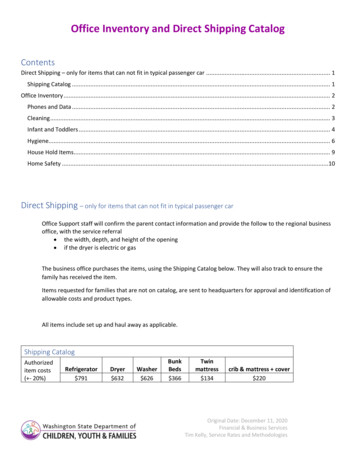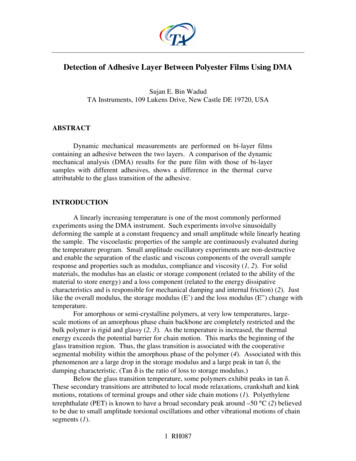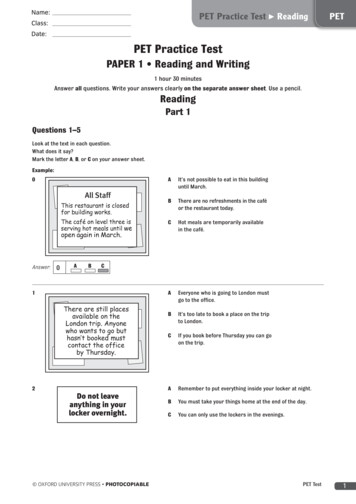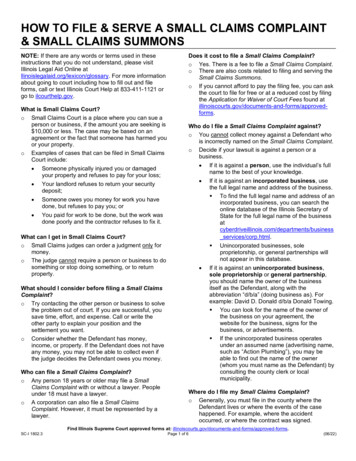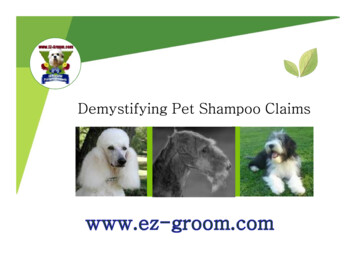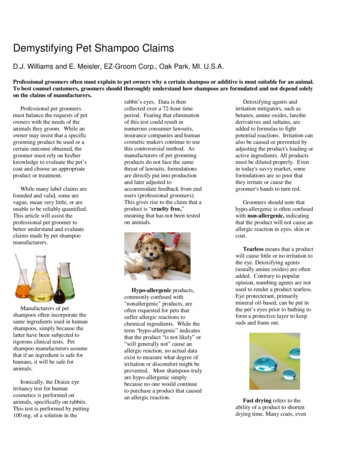
Transcription
Demystifying Pet Shampoo ClaimsD.J. Williams and E. Meisler, EZ-Groom Corp., Oak Park, MI. U.S.A.Professional groomers often must explain to pet owners why a certain shampoo or additive is most suitable for an animal.To best counsel customers, groomers should thoroughly understand how shampoos are formulated and not depend solelyon the claims of manufacturers.rabbit’s eyes. Data is thenDetoxifying agents andProfessional pet groomerscollected over a 72-hour timeirritation mitigators, such asmust balance the requests of petperiod. Fearing that eliminationbetanes, amine oxides, lanolinowners with the needs of theof this test could result inderivatives and sultains, areanimals they groom. While annumerous consumer lawsuits,added to formulas to fightowner may insist that a specificinsurance companies and humanpotential reactions. Irritation cancosmetic makers continue to usegrooming product be used or aalso be caused or prevented bythis controversial method. Ascertain outcome obtained, theadjusting the product's loading ormanufacturers of pet groominggroomer must rely on his/heractive ingredients. All productsproducts do not face the sameknowledge to evaluate the pet’smust be diluted properly. Eventhreat of lawsuits, formulationscoat and choose an appropriatein today's savvy market, someare directly put into productionproduct or treatment.formulations are so poor thatand later adjusted tothey irritate or cause theaccommodate feedback from endWhile many label claims aregroomer's hands to turn red.users (professional groomers).founded and valid, some areThis gives rise to the claim that avague, mean very little, or areGroomers should note thatproduct is “cruelty free,”unable to be reliably quantified.hypo-allergenic is often confusedmeaning that has not been testedThis article will assist thewith non-allergenic, indicatingon animals.professional pet groomer tothat the product will not cause anbetter understand and evaluateallergic reaction in eyes, skin orclaims made by pet shampoocoat.manufacturers.Tearless means that a productwill cause little or no irritation tothe eye. Detoxifying agents(usually amine oxides) are oftenadded. Contrary to popularopinion, numbing agents are notused to render a product tearless.Hypo-allergenic products,Eye protecterant, primarilycommonly confused withmineral oil-based, can be put in"nonallergenic" products, areManufacturers of petthe pet’s eyes prior to bathing tooften requested for pets thatshampoos often incorporate theform a protective layer to keepsuffer allergic reactions tosame ingredients used in humansuds and foam out.chemical ingredients. While theshampoos, simply because theterm “hypo-allergenic” indicateslatter have been subjected tothat the product “is not likely” orrigorous clinical tests. Pet“will generally not” cause anshampoo manufacturers assumeallergic reaction, no actual datathat if an ingredient is safe forexist to measure what degree ofhumans, it will be safe forirritation or discomfort might beanimals.prevented. Most shampoos trulyare hypo-allergenic simplyIronically, the Draize eyebecause no one would continueirritancy test for humanto purchase a product that causedcosmetics is performed onan allergic reaction.Fast drying refers to theanimals, specifically on rabbits.abilityof a product to shortenThis test is performed by puttingdryingtime. Many coats, even100 mg. of a solution in the
single coats, require hours to dry.The smart groomer shouldalways ask questions beforepaying a premium price for aproduct that claims to cut drytime.Dryness is measured by theabsence of water, which must beremoved either mechanically orby evaporation. While groomerscan control some of the factorsthat affect drying time, otherscannot be controlled, such asrelative humidity, air temperatureand coat type.The groomer can influencedrying time by selecting propertowels and dryers, implementingdifferent techniques, and usingshampoo and conditioners withadditives that cause water to“sheet.” Shampoos that claim tobe “fast drying” often containcosmetic-grade silicones thatenable water to wick away,mostly due to expedited sheetingaction. Fast drying is sometimesunsubstantiated by ingredients orscientific explanation. Tosignificantly cut drying time, theshampoo must lower the surfacetension of water on the coat.Conditioning agents, siliconesand certain natural oils do reducethe surface tension of water. Thisenables the water to bemechanically removed with atowel or a high velocity dryer.Humid air does not carrywater away as fast as dry air.Independent of this is heat, whichwill dramatically increase theair’s ability to carry water. Waterremoval via evaporation can bedoubled with about an 18 degreeF increase in temperature. Thereare two important items toremember at this point. One,most dryers, because of theirdesign, add from 12 to 20degrees F to the inlet airtemperature. Two, only a smallfraction of water is removed byevaporation. More than 95% ofwater is mechanically removedby a towel and a high velocitydryer. This underscores the needto reduce surface tension and touse high velocity air.different. Optical brightenersconvert invisible light (in the UVrange not seen by the human eye)to visible light. The effect isbrighter whites, blacker blacksand a more intense visualpresence.Enzymatic indicates that theformula incorporates enzymes,which are catalysts used to speedup and improve the efficacy ofcleaning. Specialty formulas,which use protein-based enzymeadditives, act to remove proteinbased stains, such as blood,urine, feces, tears and saliva.Enzymatic does not indicate thepresence of harsh detergents,such as soap or bleach. Heatgenerally will assist with theefficacy of enzymes to breakdown protein-based stains.Medicated shampoosindicate a formula that treatsproblematic coats and skin.Many books and articles havebeen published on those naturalextracts, oils and plants withknown positive clinicaloutcomes. Although the list istoo exhaustive to include in onearticle, here are the additivesmost popularly used in petshampoos: Coal tar relieves flaking,but has an odor that isdisagreeable to mostgroomers. Sulfur, a commonadditive, alleviatesvarious conditions, suchas psoriasis and eczema.Optical brighteners andcolor enhancers indicateinclusion of ingredients that aresubstantive to the coat anddeposit on the shaft to improveoptical response. While a fewnatural dyes can and willenhance color, they are verydifficult to control. In thehuman cosmetics world, manyproducts include color pigmentviolet #2 to add shimmer.Although both rely on smalldeposits on the hair cuticle, colorenhancers, often confused withoptical brighteners, are entirely Oil of wintergreen, alsosynthetically produced assalicylic acid, is afavorite of manyformulators as it is aneffective analgesic andanti-inflammatory. Zinc pyrithione, theleading active ingredientin Head and Shoulders ,boasts antifungal andantibacterial propertiesthat help eliminate dryflaking (dandruff inhuman cosmetics).2
Benzoyl peroxide wasfirst developed to treatacne in the 1920s by JackBreitbart of Revlonlaboratories. Benzoylperoxide is used in verylow ratios. Meadowsweet, anothersoothing analgesic andanti-inflammatory,contains chemicals usedto make aspirin. Comfrey, another herb,contains allantoin, a cellthat speeds up the naturalreplacement of bodycells. Comfrey has beenused for centuries toassist in healing wounds.ticks are a second source ofitching problems. Third, itchingcan result from over bathing andunder rinsing.Sebum is stripped from a pet'scoat if bathed too frequently. Acoat without sufficient sebum isprone to dryness and otherailments. Conditioners can helpalleviate the problem.To avoid drying out the coat,groomers must properly dilute allproducts and thoroughly rinse allshampoos. This is especiallyimportant for double-coated dogswhose coats do not fully dry inhumid environments. To resolveitching problems, the groomershould identify the root cause.Diet and defleeing should not beoverlooked. Chamomile is used inear ointments and as arelaxant. Selenium sulfide is anantifungal agent oftenused in shampoos to treatdandruff and seborrheicdermatitis. Oatmeal is a popularadditive for soothing andhealing coats.Itching results from one ofthree things: diet, fleas orbathing. Diet would refer tofoods that are rich in corn, wheat,wheat gluten or rice protein(common allergents). Fleas andConditioning shampoos havemigrated from the human to thepet cosmetics industry. Whileshampoos remove oil-baseddeposits, conditioners, known asquaternaries, are in fact oilbased. Conditioners can beincluded in shampooformulations or appliedseparately. Aware of theimportance of sebum for healthyskin and hair, it is clear thatreplenishing the coat withorganic and natural “substitute”oil is needed.This is accomplished withconditioners, which also improvebrushability and compatibility.Brushability offers a two-foldbenefit. One, the easier theanimal is to brush, the less timethe groomer needs to spend withthe pet. Second, the easier thebrush moves through the coat,the less damage caused to thehair cuticle during grooming.Conditioners also helpminimize “fly away,” whichoccurs when hair becomesnegatively charged. Physics 101tells us that like charges repeland unlike charges attract. Hairstrands have an inherentlynegative charge. As such, theytend to repel one another,creating fly away. Dry, thin andovergroomed hair is moresusceptible to fly away.Conditioner helps eliminate thiscondition by neutralizing thenegative charge on the hairstrands and adding needed oilsand nutrients. Neutralization ofthe charge, heavier weight fromconditioner coating, and additionof oil all work together toeliminate fly away. Conditionersassist to repair the hair’s medulla,cortex and cuticle, thereby,minimizing the appearance ofsplit ends. The improved surfacecondition (the cuticle) assists thehairs to align with each other.This improved pattern results in amore uniform surface reflectionof light, thus, producing “shine.”Deshedding, dematting anddetangling are accomplishedwith conditioners and cosmeticgrade silicones and additives thathelp rejuvenate the coat. Theseadditives assist the cuticle strandsto become parallel and adjacentwith minimal mechanical work.When this condition exists, theundercoat is made moreaccessible for deshedding. Mostof these formulations are highlyeffective when used properly.3
Although most deshedding,dematting or detangling productsare designed specifically for useeither before or after bathing, afew can be used at either time.Some products are sold as aconcentrate additive, enablingadditional deshedding anddetangling during bathing. Suchadditives turn a standardshampoo into an upgraded“detangler" or "dematter.” Keepin mind that only an ounce ortwo of the concentrate should beadded to each gallon of shampoo.Comfrey or other herbscontaining allantoin may beincluded to help deshed theanimal.Flea control formulations fallinto two primary groups: kill orrepel. Flea shampoos are onlyeffective during bathing and willnot prevent fleas from jumpingon the pet when the lather isgone. The seed cases ofchrysanthemums, which containneurotoxins called pyrethrins, aregrown commercially to supplypyrethrin-based insecticides.These chemicals should be usedcautiously as it takes the body anumber of hours or days toprocess and clear. Moreover,these chemicals can accumulateover short periods of time. Assuch, environmentalists prefer Dlimonene or oil of wintergreenfor both their efficacy andquicker breakdown as comparedto traditional oranophosphates,organochlorides and pyrethrins.Pesticide contractors in southernCalifornia offer “no move out”termite control using Dlimonene. The state of New Yorkincludes oil of wintergreen on itslist of reduced risk pesticides andbiopesticides.A host of flea-eliminatingproducts are available for useanytime. These include tabletstaken orally by the pet or spot-onproducts applied to the back ofthe animal's neck. The tabletsrelease cyothioate in thebloodstream, which kill the fleaafter it bites. Spot-on productscontaining imidocloprid, fipronil,methoprene spread from theapplication site to the entire coat.One of the benefits of the skintreatments is their ability to killfleas before they bite.Unfortunately, fleas oftendevelop resistance toinsecticides, making flea controldifficult and creating the need tomix and match strategies.Safe for cats means that aproduct will not harm a feline asit performs self-grooming. Teatree oil, for example, is anexcellent ear cleaner, boastingantimicrobial, emulsifying andcleaning properties. However,errant or residual tea tree oil lefton the cat can irate its salivaglands, causing hypersalivation.Coal tar, likewise, may createproblems when licked by cats.Shampoos effective in hardwater or well water rely uponinclusion of special additivescalled chelating agents. Ruralareas or even "city water" can befull of minerals. Premiumshampoos include chelatingagents, also known assequestering agents, which alloweffective cleaning in difficultwater. Chelating agentssometimes show up on the labelas EDTA, an acronym forethylene diamine tetra acidicacid.Chelating agents also preventaccumulation of scum around thefoaming line on solid surfaces.Chelating agents form acoordinate bond with free metalions, such as calcium, iron andmagnesium, to enable aformulation to work in hardwater. (This also helps to preventdiscoloration.) EDTA isavailable in a variety of forms.High pH water can challengesome mild ammonium-basedALES- and ALS- (ammoniumlaurel ether sulfate andammonium laurel sulfate) typesurfactants as ammonium gasmay be released creating a foulurine-like odor if the pH isallowed to range between sevenand nine.Claims about deodorizingshampoos are based on inclusionof enzymes, oxygen-baseddeodorizers, biocides, modifiersor masking agents used toeliminate or mask bad smells.Although oxygen-baseddeodorizers will eliminate odorsand are a good spot treatment asthey tend to be relatively fast andeffective, they can be veryaggressive. Such formulations4
contain hydrogen peroxide orsodium percarbonate, which canbleach the fur. Enzyme-baseddeodorizers tend to be"friendlier" and less irritating.The “friendly” enzyme attacksthe contaminating bacteria,acting as a catalyst to break itdown quickly. Hence, theenzyme formulations areeliminators not just cover-ups.Biocides are simply chemicalsthat kill odor-causing bacteriaand fungus, thus, the use of thesuffix "cide." Biocides aredeodorizers that target specificapplications, and are commonlyreferred to as bactericide, sanicide, etc. Any chemicaldeodorizer that claims to killbacteria, microorganisms or othermatter is a biocide. This wouldinclude benzethonium chloride,used as antimicrobial agent incosmetics and personal careproducts like anti-itch ointmentsand antibacterial moist towelettesand wipes. Biocides are favoredas deodorizers because they oftencan be used in or as apretreatment, and then rinsed outduring cleaning. Modifiers workby changing the structure of theodor-causing matter andattaching themselves to thesource which alters molecularmakeup. This causes the odor toappear be perceived differentlyor to disappear. Modifiers are notcommonly used in shampoos, butare prevalent in manufacturingwhere the target is known and isconsistent. Masking agents arechemical applications that add agood odor to a bad odor. Addinga masking agent to contaminationdoes not do anythingpermanently. It simply gives offa pleasant scent and "masks" thebad odor.Ingredients. New Jersey:Micelle Press, Inc.Shelf life and "pot" life aremaintained with preservatives,often benzol alcohol,chloromethylisothiazolononeand methylisothiazolonone in asolution of antimicrobialtriethanolamine or TEA.Although only a small amount ofthese chemicals are needed, it isimportant that they be fullydispersed and blended into theproduct. Shampoos andconditioners quickly becomerancid without preservatives.Cosmetic Bench Reference,Allured Publishing Company,Abbott Park, IL 1998E. Flick (1989) Cosmetic andToiletry Formulations, SecondEdition, Park Ridge New Jersey:Noyes Publications.A. O’Lenick, Jr. (2005)Surfactants: Strategic PersonalCare Ingredients, Carol StreamIL, Allured Publishing Corp.J.B. Wilkinson, R.J. Moore(1982) Harry’s Cosmeticology,New York, N.Y. ChemicalPublishing Inc.Rancidity issues aregenerally caused by dirtydispensing systems, or residualshampoos and conditioners thatare so highly diluted that theylack the preservatives needed toremain fresh. Rancidity can becountered by carefully rinsingtanks, hoses and applicators withcommon disinfectants.Williams, Daniel J. “Acomparison of surfactants in thelaboratory with respect toviscosity.” EZ-Groom InternalPublication May 12, 2006.C. Zviak, (1986) The Science ofHair Care, New York, NewYork, Marcel Decker.ReferencesMeisler, Elliezer . “Influence ofChelating Agents on Viscosity.”EZ-Groom Internal Publication.February 12, 1994.A.L. Hunting (1985).Encyclopedia of Shampoo5
Demystifying Pet Shampoo Claims D.J. Williams and E. Meisler, EZ-Groom Corp., Oak Park, MI. U.S.A. Professional groomers often must explain to pet owners why a certain shampoo or additive is most suitable for an animal. To best counsel customers, groomers should thoroughly understand how shampoos are formulated and not depend solely
